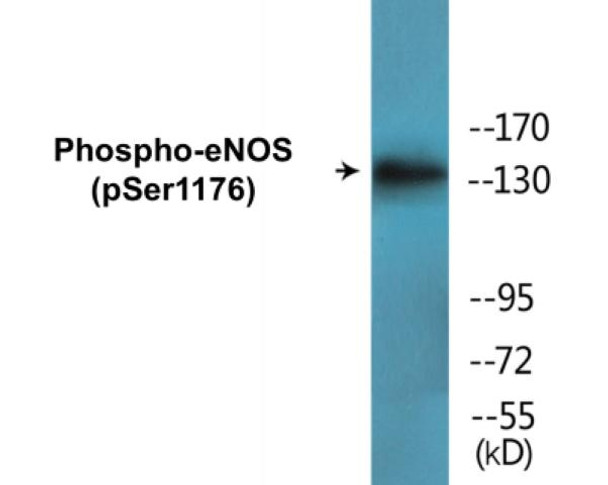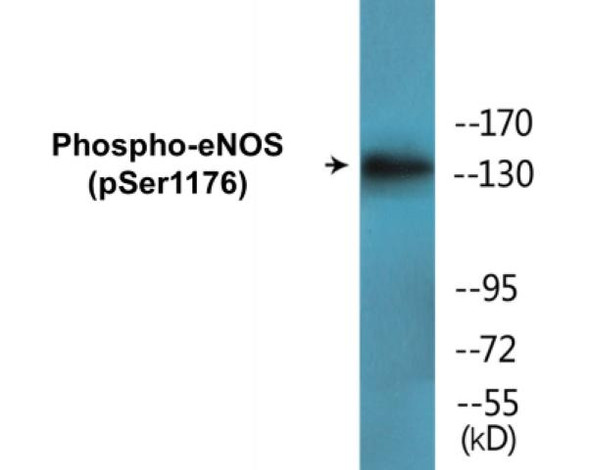Description
eNOS (Phospho-Ser1176) Cell-Based ELISA Kit
The eNOS (Phospho-Ser1176) Cell-Based ELISA Kit is a convenient, lysate- free, high throughput and sensitive assay kit that can monitor eNOS phosphorylation and expression profile in cells. The kit can be used for measuring the relative amounts of phosphorylated eNOS in cultured cells as well as screening for the effects that various treatments, inhibitors (ie. siRNA or chemicals), or activators have on eNOS phosphorylation.
How does our eNOS (Phospho-Ser1176) Fluorometric Cell-Based ELISA Kit work?
Qualitative determination of eNOS (Phospho-Ser1176) concentration is achieved by an indirect ELISA format. In essence, eNOS (Phospho-Ser1176) is captured by eNOS (Phospho-Ser1176)-specific primary (1°) antibodies while Dye 1-conjugated and Dye 2-conjugated secondary (2°) antibodies bind the Fc region of the 1° antibody. Through this binding, the dye conjugated to the 2° antibody can emit light at a certain wavelength given proper excitation, hence allowing for a fluorometric detection method. Due to the qualitative nature of the Cell-Based ELISA, multiple normalization methods are needed:
| 1. | A monoclonal antibody specific for human GAPDH is included to serve as an internal positive control in normalizing the target RFU values. |
| 2. | An antibody against the nonphosphorylated counterpart of eNOS (Phospho-Ser1176) is also provided for normalization purposes. The RFU values obtained for non-phosphorylated eNOS can be used to normalize the RFU value for phosphorylated eNOS. |
eNOS (Phospho-Ser1176) Fluorometric Cell-Based ELISA Kit -Information
| Product Name: | eNOS (Phospho-Ser1176)Fluorometric Cell-Based ELISA Kit |
| Product Code/SKU: | FBCAB00064 |
| Description: | The eNOS (Phospho-Ser1176) Fluorometric Cell-Based Phospho ELISA Kit is a convenient, lysate-free, high throughput and sensitive assay kit that can monitor eNOS (Phospho-Ser1176) protein phosphorylation and expression profile in cells. The kit can be used for measuring the relative amounts of phosphorylated eNOS (Phospho-Ser1176) in cultured cells as well as screening for the effects that various treatments, inhibitors (ie. siRNA or chemicals, or activators have on NOS3 phosphorylation. |
| Dynamic Range: | > 5000 Cells |
| Detection Method: | Fluorometric |
| Storage/Stability: | 4°C/6 Months |
| Reactivity: | Human, Mouse, Rat |
| Assay Type: | Cell-Based ELISA |
| Database Links: | Gene ID: 4846, UniProt ID: P29474, OMIM #: 163729, Unigene #: Hs.647092 |
| Format: | Two 96-Well Plates |
| NCBI Gene Symbol: | NOS3 |
| Sub Type: | Phospho |
| Target Name: | Phospho-eNOS (Ser1176) |
Kit Principle
Figure: Schematic representation of Assay Genie Cell-Based Fluorometric ELISA principle
Kit components | Quantity |
| 96-Well Black Cell CultureClear-Bottom Microplate | 2 plates |
| 10X TBS | 24 ml |
| Quenching Buffer | 24 ml |
| Blocking Buffer | 50 ml |
| 15X Wash Buffer | 50 ml |
| Primary Antibody Diluent | 12 ml |
| 100x Anti-Phospho Target Antibody | 60 µl |
| 100x Anti-Target Antibody | 60 µl |
| Anti-GAPDH Antibody | 110 µl |
| Dye-1 Conjugated Anti-Rabbit IgG Antibody | 6 ml |
| Dye-2 Conjugated Anti-Mouse IgG Antibody | 6 ml |
| Adhesive Plate Seals | 2 seals |
Additional equipment and materials required
The following materials and/or equipment are NOT provided in this kit but are necessary to successfully conduct the experiment:
- Fluorescent plate reader with two channels at Ex/Em: 651/667 and 495/521
- Micropipettes capable of measuring volumes from 1 µl to 1 ml
- Deionized or sterile water (ddH2O)
- 37% formaldehyde (Sigma Cat# F-8775) or formaldehyde from other sources
- Squirt bottle, manifold dispenser, multichannel pipette reservoir or automated microplate washer
- Graph paper or computer software capable of generating or displaying logarithmic functions
- Absorbent papers or vacuum aspirator
- Test tubes or microfuge tubes capable of storing ≥1 ml
- Poly-L-Lysine (Sigma Cat# P4832 for suspension cells)
- Orbital shaker (optional)
Kit Protocol
This is a summarized version of the kit protocol. Please view the technical manual of this kit for information on sample preparation, reagent preparation and plate lay out.
| 1. | Seed 200 µl of desired cell concentration in culture medium into each well of the 96-well plates. For suspension cells and loosely attached cells, coat the plates with 100 µl of 10 µg/ml Poly-L-Lysine (not included) to each well of a 96-well plate for 30 minutes at 37°C prior to adding cells. |
| 2. | Incubate the cells for overnight at 37°C, 5% CO2. |
| 3. | Treat the cells as desired. |
| 4. | Remove the cell culture medium and rinse with 200 µl of 1x TBS, twice. |
| 5. | Fix the cells by incubating with 100 µl of Fixing Solution for 20 minutes at room temperature. The 4% formaldehyde is used for adherent cells and 8% formaldehyde is used for suspension cells and loosely attached cells. |
| 6. | Remove the Fixing Solution and wash the plate 3 times with 200 µl 1x Wash Buffer for 3 minutes. The plate can be stored at 4°C for a week. |
| 7. | Add 100 µl of Quenching Buffer and incubate for 20 minutes at room temperature. |
| 8. | Wash the plate 3 times with 1x Wash Buffer for 3 minutes each time. |
| 9. | Dispense 200 µl of Blocking Buffer and incubate for 1 hour at room temperature. |
| 10. | Wash 3 times with 200 µl of 1x Wash Buffer for 3 minutes each time. |
| 11. | Add 50 µl of Primary Antibody Mixture P to corresponding wells for eNOS (Phospho-Ser1176) detection. Add 50 µl of Primary Antibody Mixture NP to the corresponding wells for total eNOS detection. Cover the plate with parafilm and incubate for 16 hours (overnight) at 4°C. If the target expression is known to be high, incubate for 2 hours at room temperature. |
| 12. | Wash 3 times with 200 µl of 1x Wash Buffer for 3 minutes each time. |
| 13. | Add 50 ul of Secondary Antibody Mixture to corresponding wells and incubate for 1.5 hours at room temperature in the dark. |
| 14. | Wash 3 times with 200 µl of 1x Wash Buffer for 3 minutes each time. |
| 15. | Read the plate(s) at Ex/Em: 651/667 (Dye 1) and 495/521 (Dye 2). Shield plates from direct light exposure. |
| 16. | Wash 3 times with 200 µl of 1x Wash Buffer for 5 minutes each time. |
eNOS (Phospho-Ser1176) - Protein Information
| UniProt Protein Function: | eNOS: endothelial constitutive nitric oxide synthase. Synthesizes nitric oxide (NO) from arginine and oxygen, which is implicated in vascular smooth muscle relaxation through a cGMP-mediated signal transduction pathway. NO mediates vascular endothelial growth factor (VEGF)-induced angiogenesis in coronary vessels and promotes blood clotting through the activation of platelets. Induced in humans by caloric restriction. Stimulated by calcium/calmodulin. Inhibited by NOSIP and NOSTRIN. |
| UniProt Protein Details: | Protein type:Amino Acid Metabolism - arginine and proline; Oxidoreductase; EC 1.14.13.39 Chromosomal Location of Human Ortholog: 7q36 Cellular Component: caveola; cytoplasm; cytoskeleton; cytosol; Golgi membrane; nucleus; plasma membrane Molecular Function:actin monomer binding; cadmium ion binding; calmodulin binding; FAD binding; FMN binding; heme binding; iron ion binding; NADP binding; nitric-oxide synthase activity; protein binding Biological Process: angiogenesis; arginine catabolic process; blood coagulation; blood vessel remodeling; cell redox homeostasis; endothelial cell migration; in utero embryonic development; lipopolysaccharide-mediated signaling pathway; lung development; mitochondrion organization and biogenesis; negative regulation of blood pressure; negative regulation of calcium ion transport; negative regulation of cell proliferation; negative regulation of hydrolase activity; negative regulation of muscle hyperplasia; negative regulation of potassium ion transport; nitric oxide biosynthetic process; nitric oxide mediated signal transduction; nitric oxide metabolic process; ovulation from ovarian follicle; positive regulation of angiogenesis; positive regulation of guanylate cyclase activity; positive regulation of vasodilation; regulation of blood pressure; regulation of blood vessel size; regulation of nitric-oxide synthase activity; regulation of sodium ion transport; regulation of systemic arterial blood pressure by endothelin; regulation of the force of heart contraction by chemical signal; removal of superoxide radicals; response to heat; smooth muscle hyperplasia; vascular endothelial growth factor receptor signaling pathway Disease: Alzheimer Disease; Hypertension, Essential; Preeclampsia/eclampsia 1; Stroke, Ischemic |
| NCBI Summary: | Nitric oxide is a reactive free radical which acts as a biologic mediator in several processes, including neurotransmission and antimicrobial and antitumoral activities. Nitric oxide is synthesized from L-arginine by nitric oxide synthases. Variations in this gene are associated with susceptibility to coronary spasm. Multiple transcript variants encoding different isoforms have been found for this gene. [provided by RefSeq, May 2009] |
| UniProt Code: | P29474 |
| NCBI GenInfo Identifier: | 266648 |
| NCBI Gene ID: | 4846 |
| NCBI Accession: | P29474.3 |
| UniProt Secondary Accession: | P29474,Q13662, Q14251, Q14434, Q548C1, Q6GSL5, Q9UDC6 A0S0A7, A0S0A8, A8KA63, B2RCQ1, E9PFR2, |
| UniProt Related Accession: | P29474 |
| Molecular Weight: | |
| NCBI Full Name: | Nitric oxide synthase, endothelial |
| NCBI Synonym Full Names: | nitric oxide synthase 3 |
| NCBI Official Symbol: | NOS3 |
| NCBI Official Synonym Symbols: | eNOS; ECNOS |
| NCBI Protein Information: | nitric oxide synthase, endothelial |
| UniProt Protein Name: | Nitric oxide synthase, endothelial |
| UniProt Synonym Protein Names: | Constitutive NOS; cNOS; EC-NOS; Endothelial NOS; eNOS; NOS type III; NOSIII |
| Protein Family: | Nitric oxide synthase |
| UniProt Gene Name: | NOS3 |
| UniProt Entry Name: | NOS3_HUMAN |







